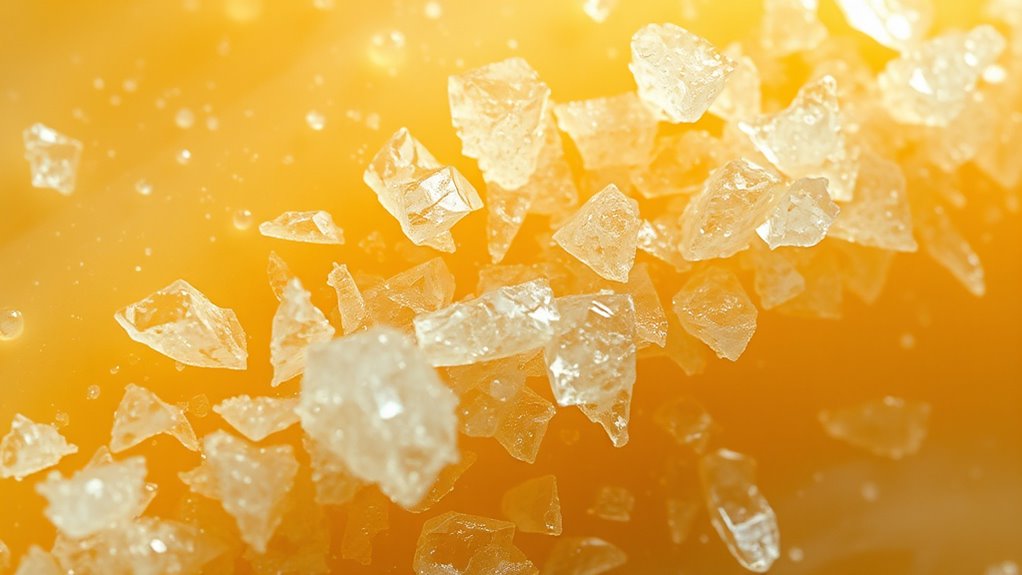Crystallization in palm wax can create stunning textures or spoil the look if not controlled carefully. When you adjust cooling rates and environmental factors, you can achieve sleek, uniform surfaces or intricate, textured patterns that enhance your candle’s visual appeal. Rapid cooling usually results in smaller crystals, while slow cooling forms larger, more dramatic ones. To master this process and avoid common issues, explore the techniques that influence crystal formation—your new skills await just beyond these insights.
Key Takeaways
- Proper cooling control can create stunning crystal patterns or cause uneven textures in palm wax candles.
- Rapid cooling yields small, uniform crystals for a sleek look, while slow cooling produces larger, decorative crystals.
- Environmental factors like humidity and temperature significantly influence crystal development and surface finish.
- Overly large or uneven crystals may lead to surface cracking, affecting candle appearance and durability.
- Mastering crystallization techniques enhances the aesthetic appeal and prevents spoiled or undesirable textures.

Crystallization in palm wax is a key process that affects the appearance and texture of your candles. When palm wax cools and solidifies, it naturally forms crystals that create unique surface patterns. These texture variations can range from smooth and sleek to highly textured and intricate, depending on how you control the cooling process. Understanding how crystallization works allows you to influence the final look of your candles, turning a simple product into a stunning piece of art or, if mishandled, a less desirable one.
Crystallization shapes your candle’s surface, from smooth elegance to textured artistry, depending on cooling control.
The way you manage cooling techniques directly impacts the crystallization pattern. For example, rapid cooling tends to produce smaller, more uniform crystals, giving your candle a smooth and consistent surface. Conversely, slow cooling encourages larger crystal formation, which results in more pronounced, textured surfaces. By adjusting the temperature and cooling rate, you get more control over the texture variations on your candle’s surface. It’s a delicate balance: too fast, and you might get a uniform, glossy finish; too slow, and you may end up with an overly textured or uneven surface that spoils the aesthetic.
If you’re aiming for a specific look, like a sleek, polished finish, you’ll want to implement cooling techniques that promote rapid solidification. This might mean placing your poured candle in a cooler environment or refrigerating it briefly before it fully sets. On the other hand, if you prefer a rustic, textured appearance with visible crystal patterns, slower cooling in a controlled environment allows larger crystals to form naturally. You can even experiment with temperature gradients or insulate certain parts of your candle to encourage interesting crystal formations. These techniques give you creative freedom but also require patience and attention to detail.
Keep in mind that the environment plays a significant role. Humidity, ambient temperature, and even the type of vessel you use can influence crystallization. When you master cooling techniques, you gain the ability to manipulate texture variations intentionally, adding an artistic touch to your candles. Proper cooling not only affects the visual appeal but also impacts the candle’s burn quality and overall durability. If crystals form unevenly or excessively large, it can compromise how evenly your candle burns or even cause surface cracking. Additionally, understanding the crystallization process can help you troubleshoot issues and improve your candle-making skills.
Frequently Asked Questions
Can Crystallization Be Prevented Entirely in Palm Wax?
You can’t prevent crystallization entirely in palm wax, but you can minimize it. Using chemical inhibitors can slow down crystal formation, while proper storage conditions—cool, stable temperatures—help prevent it from becoming a problem. Keep your wax in a consistent environment and avoid temperature fluctuations. These steps won’t eliminate crystallization, but they markedly reduce its appearance, helping you maintain a smoother, more uniform wax for your projects.
Does Crystallization Affect the Scent Throw of Palm Wax Candles?
Imagine your candle as a symphony, where scent dispersion and fragrance diffusion are the melodies that fill the room. Crystallization in palm wax can create tiny mountains on the surface, acting like barriers that hinder scent escape. While it might add visual charm, it can also dampen your candle’s ability to release fragrance evenly, making your scent throw less consistent. So, yes, crystallization can indeed influence how your candle’s aroma disperses.
Are Certain Palm Wax Varieties Less Prone to Crystallization?
You might wonder if some palm wax varieties have lower crystallization tendencies. The answer is yes; certain palm wax varieties, like softer or more refined types, tend to resist crystallization better. By choosing these varieties, you can reduce the risk of unwanted crystallization, ensuring your candles stay smooth and appealing. Always consider the wax’s composition and processing methods, as they profoundly influence crystallization tendencies and your candle’s overall look.
How Does Crystallization Impact the Candle’S Burning Performance?
Crystallization can affect your candle’s burning performance by causing texture change, which might lead to uneven burning or tunneling. While some see it as enhancing the aesthetic appeal with a unique look, others find it undesirable. Crystals can disrupt the wax’s smooth surface, impacting how evenly your candle melts. Ultimately, crystallization influences both the function and appearance, so understanding its effects helps you choose waxes that meet your desired balance of performance and style.
Is Crystallization Reversible or Treatable After It Occurs?
You might wonder if crystallization reversal or crystallization treatment can fix palm wax once it crystals. While some crystallization can be softened with gentle heating, complete reversal isn’t always possible. Applying a careful crystallization treatment, like warming the wax slightly, may improve its appearance or texture. However, you should know that extreme crystallization often requires re-melting and re-pouring for the best results, so prevention is key.
Conclusion
Crystallization in palm wax can create stunning textures, but it’s a double-edged sword. Did you know that around 85% of palm wax candles develop visible crystals over time? While some see this as a beautiful natural phenomenon, others worry it signals spoilage. Ultimately, understanding these crystals helps you decide whether they’re a charming feature or a flaw. Keep an eye on your candles—what may seem spoiled might just be nature’s unique signature.









